Dual Test: Sony Ericsson Xperia X10 mini and X10 mini pro
Despite Habr's love for Androids, reviews of the popular android phones from Sony Ericsson Xperia series somehow bypassed us. Fix this annoying misstep:

The Sony Ericsson Xperia X10 mini (and mini pro) is a smaller, but not least, modification of the “big” Sony Ericsson Xperia X10 smartphone. They came out almost simultaneously with the “older” brother, and differ from it in size, price and positioning, but at the same time retain almost all the capabilities of the “older” model.
')
Some time ago, the long-awaited release of firmware 2.1, which was the formal reason for this review, took place. And the reason ... however, about this later, although attentive readers can guess right now.
Phones are mainly distinguished by the presence of a keyboard - the X10 mini pro has it, a qwerty key pushing to the side, and the X10 mini offers only a touch screen and a couple of function buttons.
Boxes with phones differ in about how the phones themselves - the Xperia X10 Mini goes in a flat box, and the Xperia X10 Mini pro in the drawer is more impressive:

The configuration is also slightly different: by default, with both devices, in addition to the actual phones and batteries, there is a Micro USB cable, headphones with a remote control, a 2 GB microSD memory card and user documentation. A nice bonus - instead of a separate charging from the network - a regular plug with USB input:
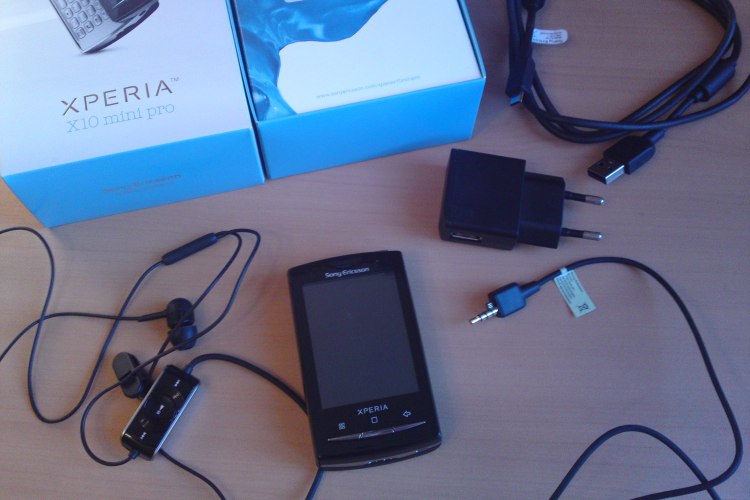
Sly retailers who sold the most primitive device for 300-500 rubles will no longer be able to cash in on us :)
With X10 mini, there are additionally color 2 interchangeable back panels:

Mini insides:

Mini pro internals:

The design also spreads models in different corners of the ring - despite the same screen size and identical filling, the mini pro looks more powerful, more brutal and even the inscriptions on it are larger. Just mini is thinner, sleeker and lighter.
In general, both Xperia mini look like smaller copies of the “older” X10 model. And the differences between them are due to the form factor of the models - X10 mini pro is expectedly thicker, slightly wider and taller (52x90x17 mm vs. 50x83x16 mm):
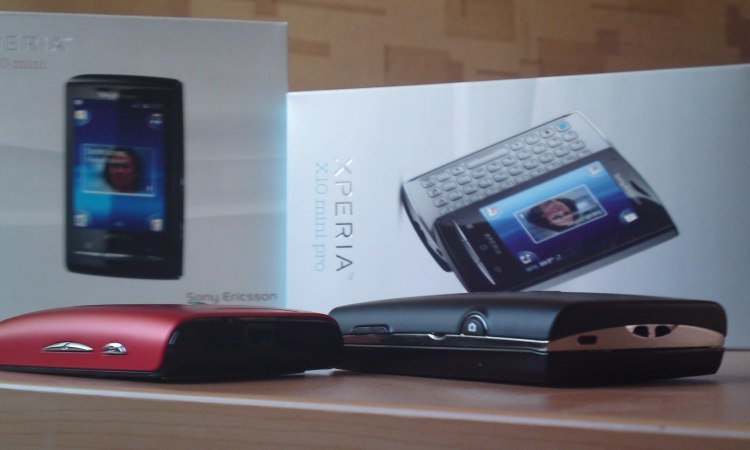
Otherwise, the differences at the level of nuances — on the “mink” —the back cover is more arched (this is a feature of the latest Sony Ericsson models in general - such a body fits more easily into the palm of the hand), the USB connector is closed with a lid, and the side buttons are made “for metal”.
In the automotive world, compact modifications of expensive cars are sometimes produced. Such machines are positioned half a step below the source, cost a little less, but are not inferior in filling and interior quality. The reduction of the "X-ten" was the same scenario - despite the smaller size and price, the quality and content of the model did not fall. Well, I will tell about the filling below - but the tactile sensations from the “expensive” soft matte plastic are quite on the level.
In front, both minks are packaged in a glossy gloss, so the “fingers” remain on the case instantly - the best option when buying a phone (however, this applies to almost all touchscreen gadgets) you should immediately purchase a matte film, which you will need to stick carefully and at least scratches and greasy traces do not worry.
A set of buttons on the perimeter of the case and on the front panel is the same: the three main buttons are the context menu, the main menu and back, on the right side are the camera buttons and the “hanger” volume controls, on the top is the power off / lock. When you press once, the screen goes out and locks, and if you press and hold, you will be asked to switch to silent mode, flight mode (no networks are very convenient on the ground when you need to save battery, for example, to listen to music or read a book ) and the actual power off. Just so, holding the button, to cut down the phone does not work - and this is good. By the way, the flight mode is still convenient, when necessary, without turning off the phone, to re-register it on the network - for example, if you have gone into the negative on the account and you are no longer allowed to reboot into the Internet.
The screens on both phones are the same: 2.6-inch touchscreens, with a resolution of 240 x 320 pixels:

- and they can boast of scratch resistance (here I speak from the manufacturer’s words, didn’t check it - the test nail hurt somewhere), and even in cold weather (that's me, thanks to the heavenly office, I checked it just a few days later - in -17 after a few I didn’t notice any glitches in the cold. I didn’t check it any longer, my hands froze :) In general, I passed the test in Russian winter. Although in front, they say, the cold is stronger.
The rotating screen works fine. The turn function to save power or just for those who are annoyed can be turned off - only on the pro model will it be rotated automatically when the keyboard is extended. It is also impossible to twist the screen in all directions - it has only two positions: vertical and “on the left side”.
In terms of ease of use, both models differ in nuances, but they will need to dwell on them in more detail.
There is a little lack of hardware keys for receiving / resetting a call: with all my love for touch screens, the phone must remain a telephone and the two most important buttons on it are red and green. When an incoming call to the Mini appears a slider that you need to swing left or right, reset the button (for example, when the phone is in your pocket) the call does not work. But you can end the conversation by pressing the "back" key.
It differs in models of the location of the headphone jack. By the way, for those who used Sony Ericsson until 2010 (including for me) the standard 3.5 mm audio output is a great gift, because the old plugs with the active use of headphones loosened for about a month. Well, in general, standardization is good. Another great step in this direction is the use of a standard Micro USB connector. By the way, from 2011 it will become the industry standard.
The connector on the Mini is located, as it should be, from below (someone may think that it is put on the side, but these are already nuances). But on the Mini pro is already on top:
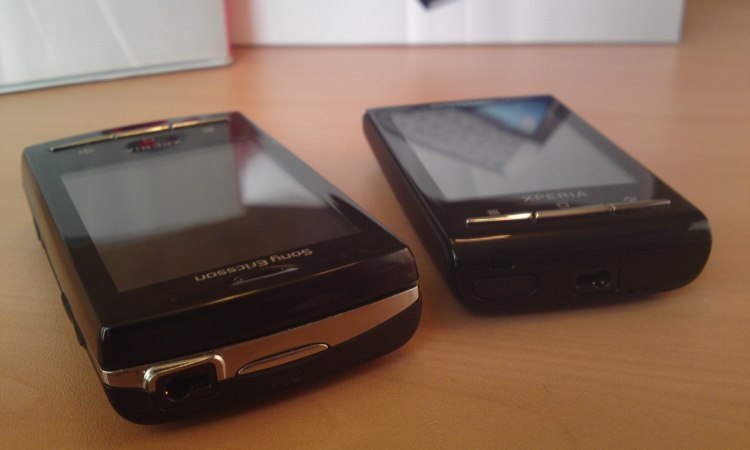
- and this, you see, when the phone is in hand, is not very convenient - the wire looms before my eyes and tries to block the screen. To carry the phone in your pocket is a more convenient solution, but then again begins to miss the hardware keys - without removing the phone from your pocket, you can only change the volume. Save the included headphones with remote control.
Extendable keyboard X10 mini pro almost full qwerty - part of the less-used letters of the Cyrillic alphabet did not fit, switching languages - only from the screen. Suitable for long letters and messages, it is easier to type a couple of words on Twitter using the on-screen keyboard. But there are no complaints about the quality of Claudia - it is excellent! Separate convex keys are easily pressed, it is almost impossible to miss or press a few at once - even with my not the smallest hands:
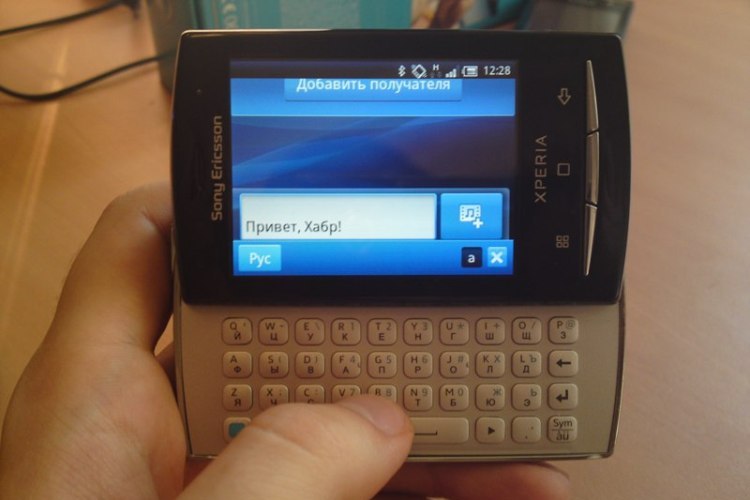
The first inclusion offers to set up a bunch of everything at once, as standard services - time, date, email, and social networking applications, wi-fi and GPS parameters. Of course you can skip all this, and set it up later. But now, for some reason, despite the choice of automatic, based on network data, settings, for some reason, it rose only with a delay of 5 minutes - MTS is a mess, or an Android glitch, I have not figured it out yet.
As in any Android, on the X10 mini, Evil Corporation offers a full set of its services: Gmail, Google Maps with the ability to view street images - StreetView, Google-search widget, Google Talk, Google VoiceSearch (checked - the word "electromic" recognized voice ):

as well as YouTube (fascinated by watching the video of Parfenov’s speech at the presentation of the Vladislav Listyev award, squandered all the money on the phone). Also, a QR code scanner is pre-installed on the device. The 600 MHz processor (for comparison - as on the first iPhone) works very fast on such a small device, and the machine does not slow down at all.
In addition to the standard features of the platform, Sony Ericsson is actively implementing its own features. One of them is a funny and entertaining thing called Timescape, a general tape of events in social networks - Twitter, Facebook, Vkontakte - and on the phone: a log of missed calls, sms and mms-messages.

You can configure the automatic update, but it will eat traffic in regular mode even when I do not watch, so I turned on the update on demand. You can also choose
WebKit browser provides the minimum required functionality - the ability to open multiple windows, bookmarks, download manager, block pop-up windows and enable / disable js:
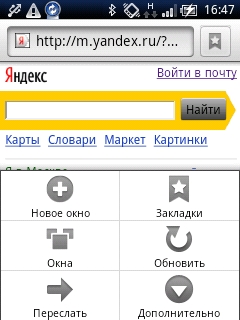
One of the promising developments of SonyEricsson is the Infinite button, which externally represents an asymmetric symbol of infinity. The meaning of the feature is that, depending on the context, it represents the maximum information about any object - be it music or a contact in your phone book. For example, in the case of a contact, he finds all events related to him (calls, sms, tweets, statuses on VKontakte and facebook), and if this is music, he will find other songs of this artist on Youtube (from which you can watch them) or in the app store PlayNow:
 →
→ 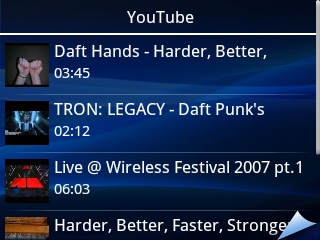
Another example of the excellent integration of the actual phone and social activity of users is the comparison of phonebook contacts to contacts in the mail and social networks. For example, after I logged in on Facebook, the phone numbers of contacts that are also there are automatically assigned to their avatars from the social network. A trifle, but nice.
Some of the contacts also assigned telephone numbers (home, work) which initially were not in my phone book, the telephone also “sucks” them from social networks.
In the contact list all contacts are displayed at once - mail, phone, and also facebook, etc. - all services with which the phone is synchronized. Despite the fact that the phone is Russified - the words in Latin come first, because of this, in order to get to the Cyrillic contacts, you need to scroll the list far down, or use the search. To avoid this mess, you just need to select the groups you want to display in the "Contacts to view" menu (for example, remove contacts without a phone number):
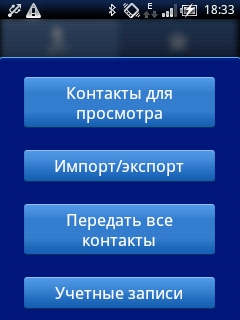 →
→ 
In firmware 1.6, by the way, there was no such possibility - everything was given out in a separate list, which could only be edited by editing contact groups in Google Mail. So one more reason in favor of updating the software is more convenient work with contacts.
In general, using the contacts menu is convenient, only the search window disappears when scrolling - if, before the middle of the screen, you need to enter, you will need to go back to the top.
Orientation on the ground is carried out using Google maps - which is logical, because This is Android, and it is reasonable - why, it is asked, to download some other maps, if Google knows everything. Definition options - by base stations (standard map application for any mobile phone) and via GPS satellites. On all Sony Ericsson Xperia lines, by the way, the AGPS system is used (or aGPS - I also met such a variant of writing), which, contrary to the existing opinion, is an improved navigation system, not a curtailed one.
GPS Assistant is a two-tier positioning system - the initial positioning is done using base stations, and then the satellites are connected. This gives a faster result than GPS cold start, which can take several minutes. The principle of operation is somewhat similar to the principle of operation of hybrid engines (I don’t know where so many car associations come to my mind, they climb themselves), which are accelerated by an electric motor, and only a few kilometers from 30-50 per hour turns on the gasoline engine.
As a bonus to navigation, the application Wisepilot goes, which, I quote from offsite, “provides color 3D maps and clear road instructions when you travel by car or on foot. It will help you in finding convenient parking lots, hotels and nearby restaurants ... including the location of speed cameras in Europe. " I don’t know about the cameras, but he finds the nearby bars, at least in Moscow,:
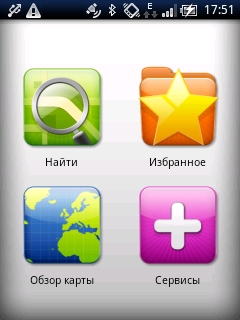

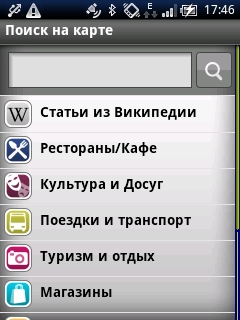
The application is paid, and on the phone is a 30-day trial. After, I suppose, you need to look for a crack on the forums :)
For me, the radio in any device is one of the most important features. Of the benefits - the lack of restrictions on the number of radio stations - it would seem a trifle, but the recently purchased Cowon J3 player for some reason has a limit of 20 stations, I have come across it before. But it’s impossible to sort and even just count how many stations have been added to favorites - you can simply switch step by step on the frequency scale:
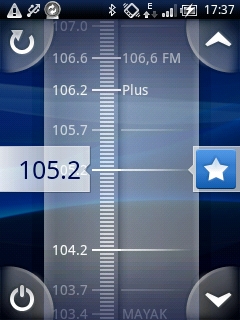
The antenna traditionally serves as a wire from the headphones (I was interested recently, they told me that Sony Ericsson had experiments with an internal antenna for radio, but they did not work, because two nearby antennas - also a telephone one - created too much interference). You can play the radio through the speaker, so everything is ok.
This device makes you wonder - why do I need a separate player? Yes, there is no heap of equalizer settings in it - but, in truth, I never use them. I prefer the version of the "weighted average" sound, without the temptation to pick it up in the settings - it won't become warm and still in tubes.
One of Sony Ericsson's favorite chips is TrackID, a music recognition service - it doesn't matter if it is playing in your player, on the radio, or even if you recorded it on the street. At one time, it was thanks to this feature that I essentially replenished my audio library - this is a big problem, when I like the track, and there is no one to get the name from.
Of course, a memory card is needed more impressively than 2 gigabytes (the phone supports microSD up to 16GB) - and then, probably, not everyone. For a day or two, there will definitely be enough music, and then you can update - you still need to charge the device periodically. And surely you need to update the headphones - yes, the headset bundled with the remote control is very convenient in the absence of keys for switching tracks on the case, and absolutely necessary in winter - when you don’t want to take your hands out of your pockets, or, on the contrary, you’ll put your hands on your gloves. But the good sound is our everything, so it’s better, of course, to bother with ear upgrade.
Speaking of charging: according to a press release, talk time is up to 3.5 hours, standby time is up to 360 hours. But these data do not tell me anything, and an actively used device causes concern for the battery already usually in a day, so I charge it every day from sin - it’s easy to plug the wire into the laptop. At the same time, you can update the music, upload photos and videos to the computer.
Fotik 5 megapixels decent, video also shoots. And more, perhaps, I have nothing to say about this :) In the photo settings, you can turn on geo-tagging (linking to the shooting location) - of course, if positioning is activated in the settings.
I got modelki with Android for another 1.6 build for review, so I updated the firmware myself - it is already available on the official website. It is not difficult - you need to download PC Companion 2.0 software, then follow the instructions on the screen. Everything is so simple and detailed that even the blonde will not get off the right path.
Immediately noticeable changes are noticeable immediately. Firstly, the unlock slider that has already become a standard has appeared - it is more convenient than the buttons on 1.6.

The menu icons have been updated, the menu itself has become more - it has become four icons more.
A couple of "minek" turned out pretty sweet. And, which is important - opposite sex :) Of course, the slide-out keyboard doesn’t make the phone so heavy or thicker that only a man can take it in hand - but without any doubt, without pro, the mini looks much more elegant, and the set of interchangeable back panels makes it great choice for girls - as a gift or for yourself.
At the same time, the mini pro itself looks quite serious, and, although the times of joking about “the only thing that men argue about - who has less”, with the advent of touch screens have passed, no one will accept the ladies' toy just because of its size.
Compact, powerful and inexpensive - these androids are successfully finding buyers, and with the new firmware there are only more arguments in favor of their acquisition.
If suddenly someone has not noticed, this post is written in the blog of the company SonyEricsson - and this is the first post in our blog. So do not minus much. The appearance of new companies on Habré has long surprised no one, so we decided not to create an entire event from this, but to start right away in the case.
The year 2010 was in many ways a turning point for Sony Ericsson: the company joined the Android smartphone race by updating the Xperia series with the X10 models, the X10 mini and X10 mini pro and Xperia X8 described above, a review of which will follow. With the transition to a new platform, the abandonment of outdated architectural solutions, the Sony Ericsson brand has found a new life and this proves the market success of the models - the entire line of Xperia androids is selling very well. For 2011, a lot of interesting new decisions are planned, about which Habr's readers will always find out among the first. For this we are here.
Hello!

The Sony Ericsson Xperia X10 mini (and mini pro) is a smaller, but not least, modification of the “big” Sony Ericsson Xperia X10 smartphone. They came out almost simultaneously with the “older” brother, and differ from it in size, price and positioning, but at the same time retain almost all the capabilities of the “older” model.
')
Some time ago, the long-awaited release of firmware 2.1, which was the formal reason for this review, took place. And the reason ... however, about this later, although attentive readers can guess right now.
Phones are mainly distinguished by the presence of a keyboard - the X10 mini pro has it, a qwerty key pushing to the side, and the X10 mini offers only a touch screen and a couple of function buttons.
Equipment
Boxes with phones differ in about how the phones themselves - the Xperia X10 Mini goes in a flat box, and the Xperia X10 Mini pro in the drawer is more impressive:

The configuration is also slightly different: by default, with both devices, in addition to the actual phones and batteries, there is a Micro USB cable, headphones with a remote control, a 2 GB microSD memory card and user documentation. A nice bonus - instead of a separate charging from the network - a regular plug with USB input:

Sly retailers who sold the most primitive device for 300-500 rubles will no longer be able to cash in on us :)
With X10 mini, there are additionally color 2 interchangeable back panels:

Mini insides:

Mini pro internals:

External similarities and differences
The design also spreads models in different corners of the ring - despite the same screen size and identical filling, the mini pro looks more powerful, more brutal and even the inscriptions on it are larger. Just mini is thinner, sleeker and lighter.
In general, both Xperia mini look like smaller copies of the “older” X10 model. And the differences between them are due to the form factor of the models - X10 mini pro is expectedly thicker, slightly wider and taller (52x90x17 mm vs. 50x83x16 mm):

Otherwise, the differences at the level of nuances — on the “mink” —the back cover is more arched (this is a feature of the latest Sony Ericsson models in general - such a body fits more easily into the palm of the hand), the USB connector is closed with a lid, and the side buttons are made “for metal”.
Housing
In the automotive world, compact modifications of expensive cars are sometimes produced. Such machines are positioned half a step below the source, cost a little less, but are not inferior in filling and interior quality. The reduction of the "X-ten" was the same scenario - despite the smaller size and price, the quality and content of the model did not fall. Well, I will tell about the filling below - but the tactile sensations from the “expensive” soft matte plastic are quite on the level.
In front, both minks are packaged in a glossy gloss, so the “fingers” remain on the case instantly - the best option when buying a phone (however, this applies to almost all touchscreen gadgets) you should immediately purchase a matte film, which you will need to stick carefully and at least scratches and greasy traces do not worry.
Buttons
A set of buttons on the perimeter of the case and on the front panel is the same: the three main buttons are the context menu, the main menu and back, on the right side are the camera buttons and the “hanger” volume controls, on the top is the power off / lock. When you press once, the screen goes out and locks, and if you press and hold, you will be asked to switch to silent mode, flight mode (no networks are very convenient on the ground when you need to save battery, for example, to listen to music or read a book ) and the actual power off. Just so, holding the button, to cut down the phone does not work - and this is good. By the way, the flight mode is still convenient, when necessary, without turning off the phone, to re-register it on the network - for example, if you have gone into the negative on the account and you are no longer allowed to reboot into the Internet.
Screen
The screens on both phones are the same: 2.6-inch touchscreens, with a resolution of 240 x 320 pixels:

- and they can boast of scratch resistance (here I speak from the manufacturer’s words, didn’t check it - the test nail hurt somewhere), and even in cold weather (that's me, thanks to the heavenly office, I checked it just a few days later - in -17 after a few I didn’t notice any glitches in the cold. I didn’t check it any longer, my hands froze :) In general, I passed the test in Russian winter. Although in front, they say, the cold is stronger.
The rotating screen works fine. The turn function to save power or just for those who are annoyed can be turned off - only on the pro model will it be rotated automatically when the keyboard is extended. It is also impossible to twist the screen in all directions - it has only two positions: vertical and “on the left side”.
Ergonomics
In terms of ease of use, both models differ in nuances, but they will need to dwell on them in more detail.
There is a little lack of hardware keys for receiving / resetting a call: with all my love for touch screens, the phone must remain a telephone and the two most important buttons on it are red and green. When an incoming call to the Mini appears a slider that you need to swing left or right, reset the button (for example, when the phone is in your pocket) the call does not work. But you can end the conversation by pressing the "back" key.
It differs in models of the location of the headphone jack. By the way, for those who used Sony Ericsson until 2010 (including for me) the standard 3.5 mm audio output is a great gift, because the old plugs with the active use of headphones loosened for about a month. Well, in general, standardization is good. Another great step in this direction is the use of a standard Micro USB connector. By the way, from 2011 it will become the industry standard.
The connector on the Mini is located, as it should be, from below (someone may think that it is put on the side, but these are already nuances). But on the Mini pro is already on top:

- and this, you see, when the phone is in hand, is not very convenient - the wire looms before my eyes and tries to block the screen. To carry the phone in your pocket is a more convenient solution, but then again begins to miss the hardware keys - without removing the phone from your pocket, you can only change the volume. Save the included headphones with remote control.
Keyboard
Extendable keyboard X10 mini pro almost full qwerty - part of the less-used letters of the Cyrillic alphabet did not fit, switching languages - only from the screen. Suitable for long letters and messages, it is easier to type a couple of words on Twitter using the on-screen keyboard. But there are no complaints about the quality of Claudia - it is excellent! Separate convex keys are easily pressed, it is almost impossible to miss or press a few at once - even with my not the smallest hands:

Turning on
The first inclusion offers to set up a bunch of everything at once, as standard services - time, date, email, and social networking applications, wi-fi and GPS parameters. Of course you can skip all this, and set it up later. But now, for some reason, despite the choice of automatic, based on network data, settings, for some reason, it rose only with a delay of 5 minutes - MTS is a mess, or an Android glitch, I have not figured it out yet.
Android
As in any Android, on the X10 mini, Evil Corporation offers a full set of its services: Gmail, Google Maps with the ability to view street images - StreetView, Google-search widget, Google Talk, Google VoiceSearch (checked - the word "electromic" recognized voice ):

as well as YouTube (fascinated by watching the video of Parfenov’s speech at the presentation of the Vladislav Listyev award, squandered all the money on the phone). Also, a QR code scanner is pre-installed on the device. The 600 MHz processor (for comparison - as on the first iPhone) works very fast on such a small device, and the machine does not slow down at all.
Sociality
In addition to the standard features of the platform, Sony Ericsson is actively implementing its own features. One of them is a funny and entertaining thing called Timescape, a general tape of events in social networks - Twitter, Facebook, Vkontakte - and on the phone: a log of missed calls, sms and mms-messages.

You can configure the automatic update, but it will eat traffic in regular mode even when I do not watch, so I turned on the update on demand. You can also choose
WebKit browser provides the minimum required functionality - the ability to open multiple windows, bookmarks, download manager, block pop-up windows and enable / disable js:

Infinite
One of the promising developments of SonyEricsson is the Infinite button, which externally represents an asymmetric symbol of infinity. The meaning of the feature is that, depending on the context, it represents the maximum information about any object - be it music or a contact in your phone book. For example, in the case of a contact, he finds all events related to him (calls, sms, tweets, statuses on VKontakte and facebook), and if this is music, he will find other songs of this artist on Youtube (from which you can watch them) or in the app store PlayNow:
 →
→ 
Contacts
Another example of the excellent integration of the actual phone and social activity of users is the comparison of phonebook contacts to contacts in the mail and social networks. For example, after I logged in on Facebook, the phone numbers of contacts that are also there are automatically assigned to their avatars from the social network. A trifle, but nice.
Some of the contacts also assigned telephone numbers (home, work) which initially were not in my phone book, the telephone also “sucks” them from social networks.
In the contact list all contacts are displayed at once - mail, phone, and also facebook, etc. - all services with which the phone is synchronized. Despite the fact that the phone is Russified - the words in Latin come first, because of this, in order to get to the Cyrillic contacts, you need to scroll the list far down, or use the search. To avoid this mess, you just need to select the groups you want to display in the "Contacts to view" menu (for example, remove contacts without a phone number):
 →
→ 
In firmware 1.6, by the way, there was no such possibility - everything was given out in a separate list, which could only be edited by editing contact groups in Google Mail. So one more reason in favor of updating the software is more convenient work with contacts.
In general, using the contacts menu is convenient, only the search window disappears when scrolling - if, before the middle of the screen, you need to enter, you will need to go back to the top.
Navigator
Orientation on the ground is carried out using Google maps - which is logical, because This is Android, and it is reasonable - why, it is asked, to download some other maps, if Google knows everything. Definition options - by base stations (standard map application for any mobile phone) and via GPS satellites. On all Sony Ericsson Xperia lines, by the way, the AGPS system is used (or aGPS - I also met such a variant of writing), which, contrary to the existing opinion, is an improved navigation system, not a curtailed one.
GPS Assistant is a two-tier positioning system - the initial positioning is done using base stations, and then the satellites are connected. This gives a faster result than GPS cold start, which can take several minutes. The principle of operation is somewhat similar to the principle of operation of hybrid engines (I don’t know where so many car associations come to my mind, they climb themselves), which are accelerated by an electric motor, and only a few kilometers from 30-50 per hour turns on the gasoline engine.
Wisepilot
As a bonus to navigation, the application Wisepilot goes, which, I quote from offsite, “provides color 3D maps and clear road instructions when you travel by car or on foot. It will help you in finding convenient parking lots, hotels and nearby restaurants ... including the location of speed cameras in Europe. " I don’t know about the cameras, but he finds the nearby bars, at least in Moscow,:



The application is paid, and on the phone is a 30-day trial. After, I suppose, you need to look for a crack on the forums :)
Radio
For me, the radio in any device is one of the most important features. Of the benefits - the lack of restrictions on the number of radio stations - it would seem a trifle, but the recently purchased Cowon J3 player for some reason has a limit of 20 stations, I have come across it before. But it’s impossible to sort and even just count how many stations have been added to favorites - you can simply switch step by step on the frequency scale:

The antenna traditionally serves as a wire from the headphones (I was interested recently, they told me that Sony Ericsson had experiments with an internal antenna for radio, but they did not work, because two nearby antennas - also a telephone one - created too much interference). You can play the radio through the speaker, so everything is ok.
Player and speakers
This device makes you wonder - why do I need a separate player? Yes, there is no heap of equalizer settings in it - but, in truth, I never use them. I prefer the version of the "weighted average" sound, without the temptation to pick it up in the settings - it won't become warm and still in tubes.
One of Sony Ericsson's favorite chips is TrackID, a music recognition service - it doesn't matter if it is playing in your player, on the radio, or even if you recorded it on the street. At one time, it was thanks to this feature that I essentially replenished my audio library - this is a big problem, when I like the track, and there is no one to get the name from.
Of course, a memory card is needed more impressively than 2 gigabytes (the phone supports microSD up to 16GB) - and then, probably, not everyone. For a day or two, there will definitely be enough music, and then you can update - you still need to charge the device periodically. And surely you need to update the headphones - yes, the headset bundled with the remote control is very convenient in the absence of keys for switching tracks on the case, and absolutely necessary in winter - when you don’t want to take your hands out of your pockets, or, on the contrary, you’ll put your hands on your gloves. But the good sound is our everything, so it’s better, of course, to bother with ear upgrade.
Battery
Speaking of charging: according to a press release, talk time is up to 3.5 hours, standby time is up to 360 hours. But these data do not tell me anything, and an actively used device causes concern for the battery already usually in a day, so I charge it every day from sin - it’s easy to plug the wire into the laptop. At the same time, you can update the music, upload photos and videos to the computer.
Camera
Fotik 5 megapixels decent, video also shoots. And more, perhaps, I have nothing to say about this :) In the photo settings, you can turn on geo-tagging (linking to the shooting location) - of course, if positioning is activated in the settings.
Differences from Android 1.6
I got modelki with Android for another 1.6 build for review, so I updated the firmware myself - it is already available on the official website. It is not difficult - you need to download PC Companion 2.0 software, then follow the instructions on the screen. Everything is so simple and detailed that even the blonde will not get off the right path.
Immediately noticeable changes are noticeable immediately. Firstly, the unlock slider that has already become a standard has appeared - it is more convenient than the buttons on 1.6.

The menu icons have been updated, the menu itself has become more - it has become four icons more.
Summary
A couple of "minek" turned out pretty sweet. And, which is important - opposite sex :) Of course, the slide-out keyboard doesn’t make the phone so heavy or thicker that only a man can take it in hand - but without any doubt, without pro, the mini looks much more elegant, and the set of interchangeable back panels makes it great choice for girls - as a gift or for yourself.
At the same time, the mini pro itself looks quite serious, and, although the times of joking about “the only thing that men argue about - who has less”, with the advent of touch screens have passed, no one will accept the ladies' toy just because of its size.
Compact, powerful and inexpensive - these androids are successfully finding buyers, and with the new firmware there are only more arguments in favor of their acquisition.
PS
If suddenly someone has not noticed, this post is written in the blog of the company SonyEricsson - and this is the first post in our blog. So do not minus much. The appearance of new companies on Habré has long surprised no one, so we decided not to create an entire event from this, but to start right away in the case.
The year 2010 was in many ways a turning point for Sony Ericsson: the company joined the Android smartphone race by updating the Xperia series with the X10 models, the X10 mini and X10 mini pro and Xperia X8 described above, a review of which will follow. With the transition to a new platform, the abandonment of outdated architectural solutions, the Sony Ericsson brand has found a new life and this proves the market success of the models - the entire line of Xperia androids is selling very well. For 2011, a lot of interesting new decisions are planned, about which Habr's readers will always find out among the first. For this we are here.
Hello!
Source: https://habr.com/ru/post/109438/
All Articles